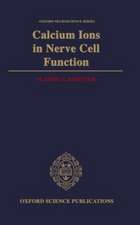Animal Models of Speech and Language Disorders
Editat de Santosh A. Helekaren Limba Engleză Hardback – 17 oct 2013
| Toate formatele și edițiile | Preț | Express |
|---|---|---|
| Paperback (1) | 945.14 lei 6-8 săpt. | |
| Springer – 22 aug 2016 | 945.14 lei 6-8 săpt. | |
| Hardback (1) | 954.45 lei 6-8 săpt. | |
| Springer – 17 oct 2013 | 954.45 lei 6-8 săpt. |
Preț: 954.45 lei
Preț vechi: 1163.97 lei
-18% Nou
Puncte Express: 1432
Preț estimativ în valută:
182.64€ • 195.30$ • 152.28£
182.64€ • 195.30$ • 152.28£
Carte tipărită la comandă
Livrare economică 18 aprilie-02 mai
Preluare comenzi: 021 569.72.76
Specificații
ISBN-13: 9781461483991
ISBN-10: 1461483999
Pagini: 350
Ilustrații: X, 295 p. 58 illus., 43 illus. in color.
Dimensiuni: 155 x 235 x 20 mm
Greutate: 0.7 kg
Ediția:2013
Editura: Springer
Colecția Springer
Locul publicării:New York, NY, United States
ISBN-10: 1461483999
Pagini: 350
Ilustrații: X, 295 p. 58 illus., 43 illus. in color.
Dimensiuni: 155 x 235 x 20 mm
Greutate: 0.7 kg
Ediția:2013
Editura: Springer
Colecția Springer
Locul publicării:New York, NY, United States
Public țintă
GraduateCuprins
Preface.- Section I – Introduction to Speech and Language Disorders.- Chapter 1. Neurology of Speech and Language Disorders.- Chapter 2. Genetic Pathways Implicated in Speech and Language.- Section II – Songbird Model of Vocal Learning.- Chapter 3. Time Scales of Vocal Learning in Songbirds.- Chapter 4. The Songbird Auditory System.- Chapter 5. Prospective: How the Zebra finch Genome Strengthens Brain-Behavior Connections in Songbird Models of Learned Vocalization.- Chapter 6. The Molecular Convergence of Birdsong and Speech.- Chapter 7. Stuttered Birdsong.- Section III – Mammalian Models of Vocal Communication.- Chapter 8. The Repertoire of Communication Calls Emitted by Bats and the Ways the Calls are Processed in the Inferior Colliculus.- Chapter 9. Language Parallels in New World Primates.- Chapter 10. Apes, Language and the Brain.
Textul de pe ultima copertă
Animal Models of Speech and Language Disorders is arguably the first book that integrates several decades of research on the neuroscience and genetics of speech and language with behavioral, systems, cellular and molecular neurobiological studies on animal communication to create a synthesis of ideas with potential translational value in neurology, neurolinguistics and speech science.
Speech and language dysfunctions plague a large segment of today’s young and old alike because, besides being primary afflictions, they are also an integral part of the complex symptomatology of most of the common neurological and neurodevelopmental disorders, such as stroke, dementia, intellectual disability and autism. It is therefore essential that biomedical research be focused on understanding their neurobiological and genetic bases in order to have the chance of developing rational approaches to treating them. By weaving together findings from diverse disciplines in the comparative biology of vocal communication in songbirds, bats, New World monkeys and the great apes, with the applied and translational perspective in mind, this book attempts to create awareness among researchers and students about the strengths of the comparative and evolutionary approach to the scientific understanding of speech and language, and to addressing intractable clinical problems affecting higher brain functions.
Animal Models of Speech and Language Disorders will be highly instructive to researchers, clinicians, advanced speech pathology and neuroscience students, and all those who are interested in the current state of knowledge in the basic and applied aspects of speech and language.
Speech and language dysfunctions plague a large segment of today’s young and old alike because, besides being primary afflictions, they are also an integral part of the complex symptomatology of most of the common neurological and neurodevelopmental disorders, such as stroke, dementia, intellectual disability and autism. It is therefore essential that biomedical research be focused on understanding their neurobiological and genetic bases in order to have the chance of developing rational approaches to treating them. By weaving together findings from diverse disciplines in the comparative biology of vocal communication in songbirds, bats, New World monkeys and the great apes, with the applied and translational perspective in mind, this book attempts to create awareness among researchers and students about the strengths of the comparative and evolutionary approach to the scientific understanding of speech and language, and to addressing intractable clinical problems affecting higher brain functions.
Animal Models of Speech and Language Disorders will be highly instructive to researchers, clinicians, advanced speech pathology and neuroscience students, and all those who are interested in the current state of knowledge in the basic and applied aspects of speech and language.
Caracteristici
Details the overall investigative approach of neurobehavioral studies in animals capable of vocal communication and learned vocalizations
A unifying review of research in this new multidisciplinary frontier
Spans the molecular to the behavioral, for clinicians and researchers
Includes supplementary material: sn.pub/extras
A unifying review of research in this new multidisciplinary frontier
Spans the molecular to the behavioral, for clinicians and researchers
Includes supplementary material: sn.pub/extras















